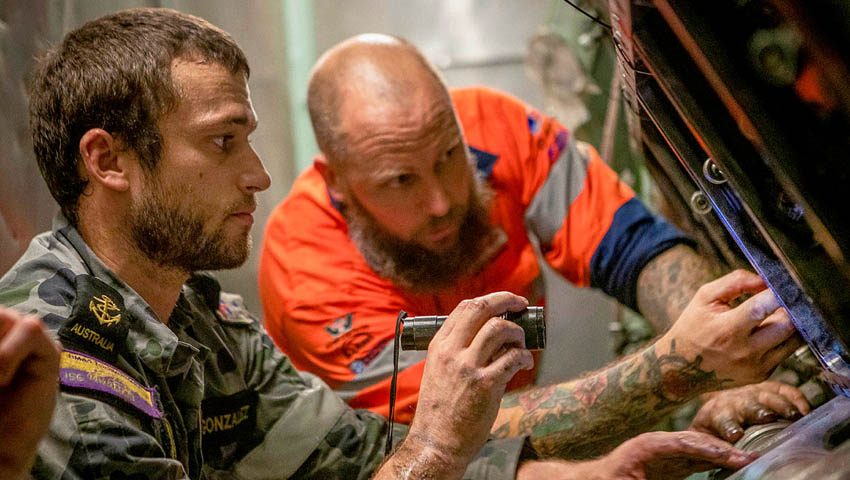The Royal Australian Navy motto of “The Team Works” is alive and well onboard HMAS Toowoomba as the ship conducts maritime security operations in the southern Arabian Gulf as part of Operation Manitou.
Toowoomba’s Marine Technicians, Fleet Support Unit and a contractor from Penske Power Systems recently worked together to demonstrate a ‘can-do’ attitude when over five days they dismantled and replaced a damaged camshaft.
Leading the team was Propulsion Chief, Chief Petty Officer Marine Technician Gregory Fletcher.
“I have around 20 years of experience in Anzac Class frigates and I was surprised to see a defect of this kind. I have seen bottom-end overhauls conducted as a result of a multitude of other common failures, but to see a camshaft degrade in this manner is definitely a first for me. I guess this is why I love the job so much. Every day brings something new and exciting,” explained CPO Fletcher.
The camshaft defect damaged two injector lobes. The ship’s operational environment required swift and precise repairs. The Navy’s civilian outplacement program also benefited the repairs.
The program offers technical sailors the opportunity to develop their specialist skills alongside civilian industry partners.
Leading Seaman Marine Technician Gregory Gonzalez, a part of the repair team, is a former Penske Outplacement Program participant.
“This repair has been an extremely rewarding opportunity as I was able to put my previous experience into practice and further my knowledge of these engines,” LS Gonzalez said.
The Australian Frigate Group’s Commander Keith Taylor said the work was an incredible effort by all involved.
“Civilian and uniformed members across a multitude of engineering, logistics and operational agencies have come together to deliver an efficient repair solution. Maintaining mission-critical capability and maintaining Australia’s commitment to international security operations is our number one priority,” CMDR Taylor explained.
HMAS Toowoomba is the seventh of eight Anzac Class frigates built by Tenix Defence Systems at Williamstown, Victoria, for the RAN. The design is based on the German MEKO 200 frigate.
Toowoomba is a long-range frigate capable of air defence, surface and undersea warfare, surveillance, reconnaissance and interdiction. Toowoomba’s combat capabilities have been significantly improved under the Anti-Ship Missile Defence upgrade program, a world-class program that provides an enhanced sensor and weapons systems capability.
The upgrade showcases Australian design and integration capability, with new phased array radar technology designed by CEA Technologies in Canberra, upgrades to combat systems performed by Saab Systems in South Australia, and platform integration design by BAE Systems in Victoria.
Toowoomba is fitted with an advanced package of air and surface surveillance radars, omni-directional hull-mounted sonar and electronic support systems that interface with the 9LV453 Mk3E combat data system. The ship can counter simultaneous threats from aircraft, surface vessels and submarines.
The ship can embark Navy’s latest multi-role Sikorsky/Lockheed Martin MH-60R Seahawk helicopter, which has enhanced anti-submarine, anti-surface warfare and search and rescue capabilities. Embarkation of a helicopter also provides the ship with the capability to deliver air-launched missiles and torpedoes.
HMAS Toowoomba is the second RAN ship to bear the name of Queensland’s inland city. HMAS Toowoomba (I) was one of 60 Bathurst Class minesweeping corvettes built in Australia during the Second World War as part of the Commonwealth government’s wartime shipbuilding program.
This will be the RAN’s 68th deployment to the Middle East region since 1990 and the sixth mission for HMAS Toowoomba.



